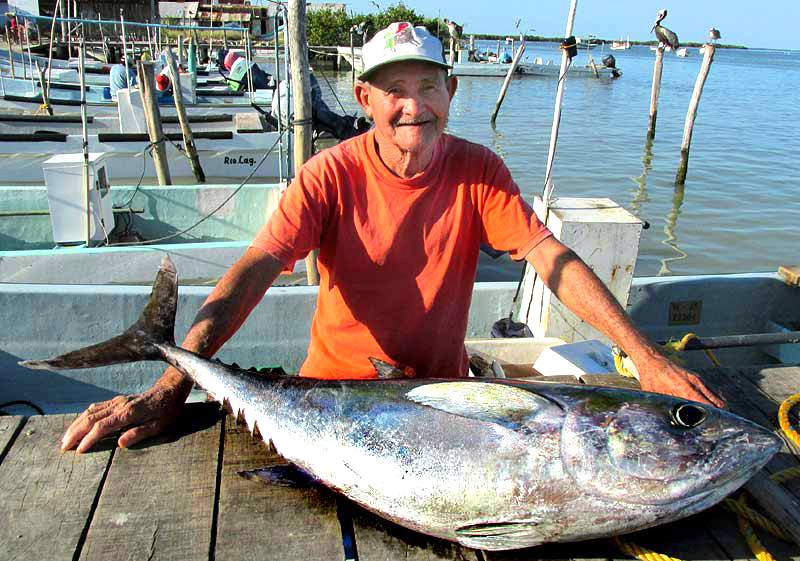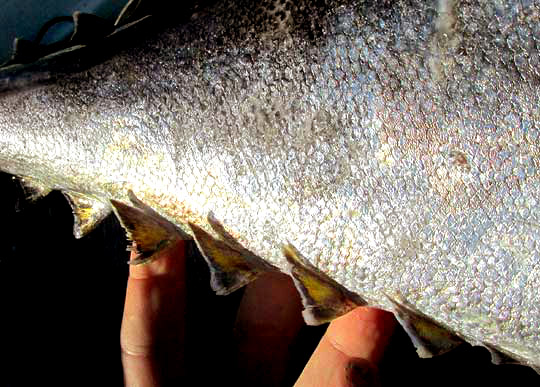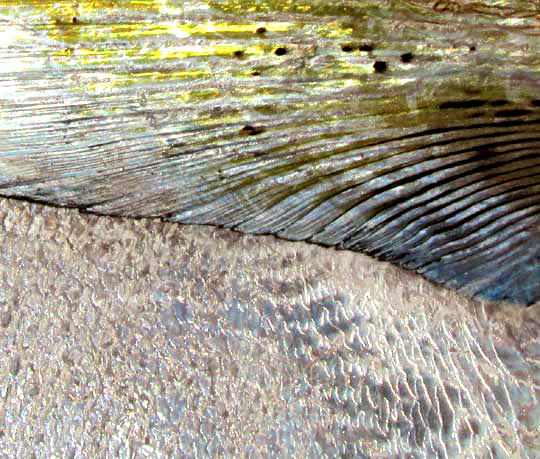Excerpts from Jim Conrad's
Naturalist Newsletter

from the March 1, 2015 Newsletter issued from Río Lagartos, on the Yucatan Peninsula's northern coast (~N21.60°, ~W88.16°), Yucatán state, MÉXICO
BLUEFIN TUNA
Rayo's grandfather, Don Taila, had spent the night in his little boat no larger than those carrying tourists up the estuary to see flamingos. But Don Taila's boat had been miles out in the Gulf of Mexico, and instead of dragging a net behind his boat, or even using a rod and reel, he'd fished the old way, with no pole, just hook, line and sinker, his hook baited with small chunks of sardine flesh, and he'd tossed the line by twirling it with his hand. Yet that morning after making his way back home to Río Lagartos, pulling up to a dock only a minute walk from his house, he brought an ice chest filled with fish. That's him above standing in his boat, with his biggest catch of the night lying on the dock before him.
I'm such a landlubber that Don Taila had to tell me that it was a tuna, though once I noticed the toothlike fins, or " finlets," near the fish's rear end, on the fish's top and bottom, I remembered that tunas do have such things. A close-up showing the bottom row of finlets is shown below:

This only indicated that we had some kind of tuna, however, for several kinds of tuna exist. So, which one was this?
The name "tuna" is a general one, applied to several fish species (as well as to certain cactus fruits). Oceanography textbooks are likely to define a tuna as a saltwater fish belonging to the tribe Thunnini, which is a sub-grouping of the Mackerel Family, the Scombridae -- which is the same family to which bonitos, mackerels, and Spanish mackerels belong. The Tuna Tribe Thunnini comprises fifteen species across five genera. Within that tribe there's the genus Thunnus whose members often are referred to as "true tunas." As things stand now, there are about eight species of "true tuna," members of the genus Thunnus, and Don Taila's fish was one of them.
Since tuna fish are so important commercially, several websites provide species identification pages, such as the one at http://www.fishwatch.gov/seafood_profiles/species/tuna/group_pages/.
Different tuna identification pages tend to list different species and use different common names, making the identification process a little tricky. Still, Don Taila's fish displays enough field marks to identity it as the Atlantic Bluefin Tuna, THUNNUS THYNNUS. One good field mark for the Atlantic Bluefin Tuna is the shortness of its side fins directly behind the gills (the pectoral fins), the tips of which don't reach the base of the second top fin (the second dorsal fin), which in our picture is the one in the center of the bottom of Don Taila's orangish shirt.
Another tuna species commonly caught here, but normally in deeper water, is the Yellowfin Tuna. However, its fins, including the ones on its bottom (the ventral and anal fins), are much longer and more slender. Technical guides say that other distinguishing marks of our Atlantic Bluefin Tuna include that its lower sides are splotched with vertical lines of white spots, and a slender, yellow line extends from its snout to about half the length of its body. Don Taila's fish doesn't show these, but local fishermen tell me that within minutes after such a fish is taken, its colors fade and such markings disappear.
Atlantic Bluefin Tunas mature at about eight years, and they typically grow to be around six feet long (2 m) long, weighing some 300 pounds (135 kg), though they've been known to reach about 1,200 pounds (550 kg). Therefore, Don Taila's catch is a small one, as far as Atlantic Bluefin Tunas go. Mostly the species lives in cooler water of the North Atlantic and adjacent seas, but they return to the Caribbean to spawn. It's unusual that a fish would move between such cold and warm waters, but it's been shown that tunas can do so while maintaining a constant internal body temperature.
Juvenile tunas typically prey on crustaceans, small fish and cephalopods such as octopuses, whiles adults feed mainly on fish such as herrings, anchovies, sardines, and mackerel.
Because of overfishing, the IUCN Red List considers the Atlantic Bluefin Tuna an endangered species. In fact, no tuna species is doing very well. The Southern Bluefin Tuna is listed as critically endangered and the Pacific Bluefin as vulnerable. The Fishwatch.Gov web page for Atlantic Bluefin Tunas reports that a giant bluefin tuna "can fetch hundreds of thousands of dollars at fish markets today."
Despite knowing that Don Taila and his family planned to eat his tuna, I felt sorry for it lying there on the dock, its eyes turning opaque and empty. Up close, its body still showed a few colors, however, and its scale patterns were intricate and beautiful. You can see some of this below:
